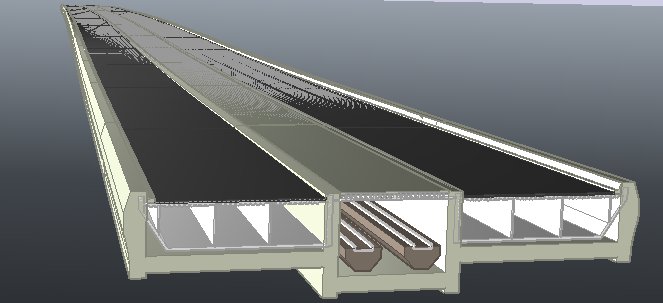 In our previous article we discussed the benefit of combining a vehicular and rail crossing located near the CIA facility. The bridge should provide a compact design that would reduce the impact to the natural environment of the Potomac. It would be the most environmentally sensitive to have no mid-river piers, therefore a cable stayed system with land piers should be preferred. Here is a quick mock up of what the transportation segments would look like.
In our previous article we discussed the benefit of combining a vehicular and rail crossing located near the CIA facility. The bridge should provide a compact design that would reduce the impact to the natural environment of the Potomac. It would be the most environmentally sensitive to have no mid-river piers, therefore a cable stayed system with land piers should be preferred. Here is a quick mock up of what the transportation segments would look like.
 Cable stayed bridges provide little benefit in the case of a road bridge for river crossings, beyond aesthetics, as in most cases the simpler and more economical choice is a standard pier and deck system. When a much more demanding live load from a heavy rail system is included the cable stay provides an efficient method of addressing the new structural requirements. The cost per mile is increased but compared to two individual bridges this method would remain more efficient.
Cable stayed bridges provide little benefit in the case of a road bridge for river crossings, beyond aesthetics, as in most cases the simpler and more economical choice is a standard pier and deck system. When a much more demanding live load from a heavy rail system is included the cable stay provides an efficient method of addressing the new structural requirements. The cost per mile is increased but compared to two individual bridges this method would remain more efficient.
By providing a pedestrian/emergency vehicle road deck above the metro rail, the bridge width is reduced and a central corridor for emergency vehicles can be provided to address bridge incidents. This also provides a greater safety in the separation of vehicles and trains that can prevent intentional attacks on the rail tracks.
The bridge is designed to carry 6 vehicular lanes of 11′ each with a 3′ shoulder and 2′ curbed retaining wall. The cable stayed towers would need to be approximately 250′ above bridge deck, for a total height over water of approximately 350′. The elevation of the towers would be approximately 100′ above the side banks of the Potomac at this part of the river. Much of the towers could be screened with vegetation. Most importantly, while the towers might have a visual impact, the water body itself can remain undisturbed without mid-span piers.




